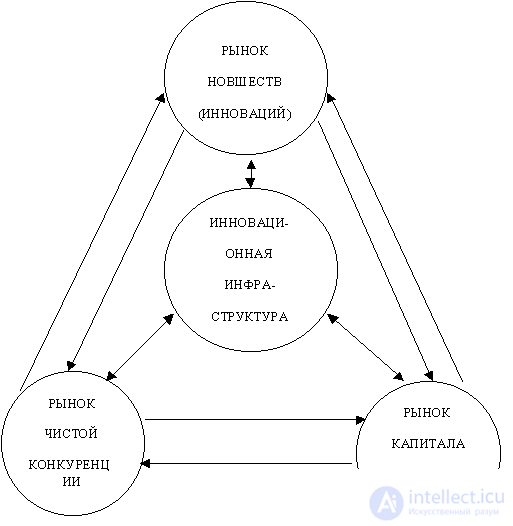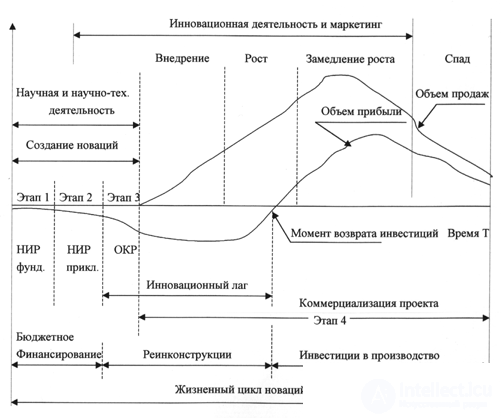Lecture
It is believed that the concept of "innovation" is the Russian version of the English word innovation. A literal translation from English means “introduction of innovations” or, in our understanding of the word, “introduction of innovations”. Innovation is a new order, a new custom, a new method, an invention, a new phenomenon . The Russian phrase "innovation" - literally "the introduction of a new" - means the process of using innovations.
Thus, from the moment of acceptance to distribution, innovation acquires a new quality — it becomes an innovation (innovation * ). The process of introducing innovations into the market is called the process of commercialization. The time period between the emergence of innovation and its embodiment in innovation (innovation) is called an innovative lag.
In everyday practice, as a rule, the concepts of "innovation", "innovation", "innovation", "innovation" are identified, which is understandable. Any inventions, new phenomena, types of services or methods only receive public recognition when they are accepted for distribution (commercialization), and already in a new capacity they act as innovations (innovations).
It is well known that the transition from one quality to another requires the expenditure of resources (energy, time, finance, etc.). The process of translating innovations (innovations) also requires the expenditure of various resources, the main of which are investment and time. In the conditions of the market as a system of economic relations of purchase and sale of goods, within which demand, supply and price are formed, the main components of innovation activity are innovations, investments and innovations. Innovations will form the market of innovations (innovations), investments - the capital market (investments), innovations (innovations) - the market of pure competition of innovations. These three main components form the sphere of innovation activity (Fig. 5.6).

Fig.5.6 The scope of innovation.
Innovation in a broad sense means profitable (profitable) use of innovations in the form of new technologies, types of products and services, organizational and economic solutions of a production, financial, commercial, administrative or other nature.
The time period from the birth of an idea, the creation and distribution of an innovation to its use is called the life cycle of innovation . Taking into account the sequence of work, the life cycle of innovation * is considered as an innovation process.
In accordance with international practice, the product life cycle is divided into smaller stages: marketing, search and market research; design and (or) development of technological requirements; product development; material and technical supply; preparation and development of production processes; production; control, testing and inspection, packaging and storage; sales and distribution of products; installation and operation; technical assistance and maintenance; product disposal after use.
In world practice, it is customary to distinguish between scientific (research), scientific and technical activities, as well as experimental (experimental design) developments * .
Scientific activities are aimed at obtaining, disseminating and applying new knowledge and include:
fundamental scientific research - experimental and theoretical activities aimed at obtaining new knowledge about the basic laws of the development of nature and society;
applied scientific research is a scientific activity aimed at achieving practical results and solving specific tasks.
Scientific and technical activity is aimed at obtaining, disseminating and applying new knowledge in the field of solving technological, engineering, economic, social and humanitarian problems, ensuring the functioning of science, technology and production as a single system.
Experimental developments are understood as systematic work, based on knowledge acquired as a result of research or on the basis of practical experience, and aimed at ensuring human life and health, obtaining new materials, products and devices, introducing new technologies and their further improvement.
The market for innovations is formed by scientific organizations, universities, temporary research teams, associations of researchers, research departments of commercial organizations, independent laboratories and departments, and domestic and foreign innovators.
The innovation process can be considered from different positions and with varying degrees of detail.
First, it can be considered as a parallel-sequential implementation of research, scientific and technical, innovation, production and marketing activities.
Secondly, it can be considered as temporary stages of the innovation life cycle from the emergence of an idea to its development and distribution.
Third, it can be viewed as a process of financing and investing the development and distribution of a new type of product or service. In this case, it acts as an innovation project, as a particular case of an investment project that is widespread in economic practice.
In general, the innovation process consists in obtaining and commercializing an invention, new technologies, types of products and services, industrial, financial, administrative or other solutions and other results of intellectual activity. The main stages and characteristics of the innovation process are presented in Fig. 5.7.

Fig. 5.7 Stages of the innovation process
Basic research * (I stage) is carried out in academic institutions, higher educational institutions and specialized industry institutes, laboratories. Financing is carried out mainly from the state budget on a non-refundable basis.
Applied research (stage II) is carried out in scientific institutions and funded both from the budget (state scientific programs or on a competitive basis) and from customers. Since the result of applied research is far from always predictable, is fraught with a large degree of uncertainty, at this stage the probability of obtaining a negative (dead-end) result is further high. It is from this stage that the risk of loss of invested funds arises and investments in innovation are risky in nature and are called risk investments, and commercial organizations (funds) engaged in risk investments are risk firms (venture).
Experimental design and experimental development (stage III) are carried out both in specialized laboratories, design bureaus, pilot production plants, and in research and production departments of large industrial enterprises. Sources of financing are the same as in the second stage, as well as the organization’s own funds.
At the fourth stage, the process of commercialization from launch into production and market entry and further along the main stages of the product life cycle is carried out.
At the turn of the third stage and entering the market, as a rule, large investments in production are required to create (expand) production capacities, staff training, promotional activities, etc. At this stage of the innovation process, the market response to innovation is not yet determined and the risks of rejection are very likely therefore, investments continue to be risky.
In order to increase production, expand markets, increase competitiveness and ensure conditions for the return (payback * ) of investment risk, this stage of the investment process involves issuing securities. It allows you to attract additional investment, to ensure their profitable use, while maintaining the competitiveness of products, services and organizations as a whole. This completes the innovation process.
Comments
To leave a comment
Management
Terms: Management